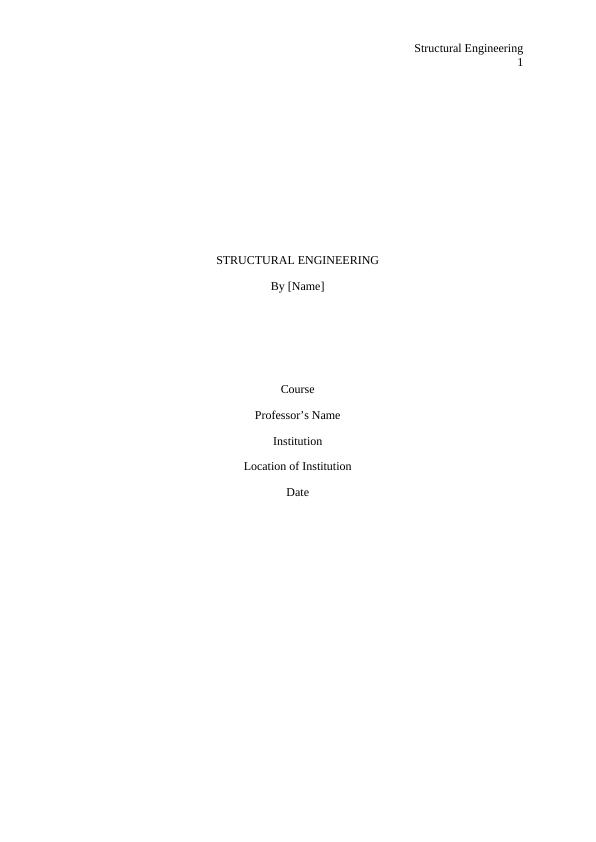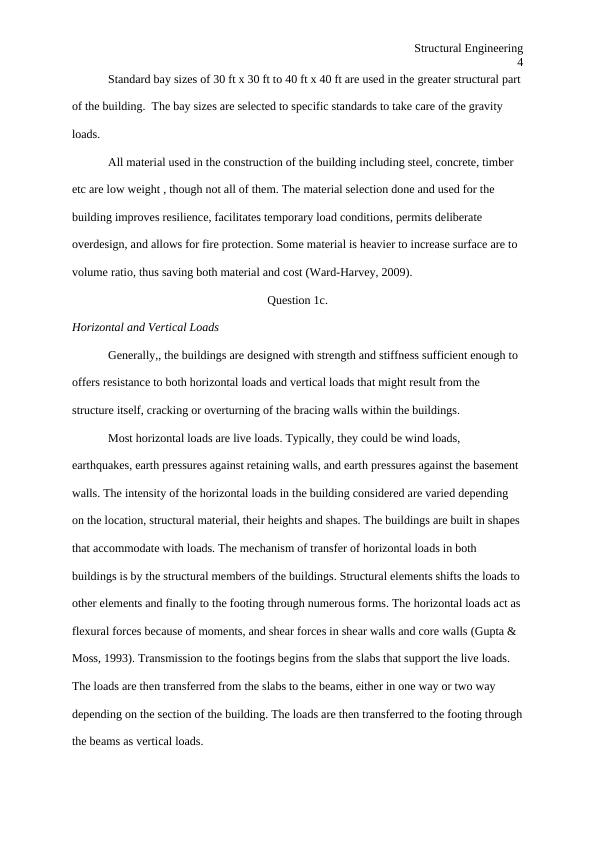Structural Engineering: Building Features, Material Choices, and Load Resistance
Added on 2023-06-14
13 Pages2106 Words249 Views
Structural Engineering
1
STRUCTURAL ENGINEERING
By [Name]
Course
Professor’s Name
Institution
Location of Institution
Date
1
STRUCTURAL ENGINEERING
By [Name]
Course
Professor’s Name
Institution
Location of Institution
Date

Structural Engineering
2
Question1a
Industrial Building – 45 Rosedale Street, Coopers plains, Qld 4108 ASX Listed Tenant
Use of the Building
The industrial building I visited is a modern commercial industrial building that is
fully leased ASX listed tenant. The building is strategically located on 45 Rosedale Street,
Coopers Plains, Qld 4108 and adjacent to the Coopers Plains trains station. This is a
commercial building that can be primarily used as a garage for all types and sizes of motor
vehicles. The facility is portioned such that it has the garage area, and also office area. There
is also space for conferences, or meetings – board rooms.
Structural Features
Structural features of the building include reinforced concrete pad foundations with
isolated footing that are associated with concrete blinding, grade beams and exterior concrete
slab. Framing systems for roofs with designed structural steel i.e. for roof trusses. The
building is also decked with a composite concrete steel system and structurally designed
beam and columns connection systems. Other structural features of the building include wood
trusses, I-joists, floor trusses in some areas and engineered beams, columns and headers.
Multistorey Building – One One One Eagle Street
Use of the Building
The One One One Eagle street is a multistorey building at Brisbane city centre, 111
Eagle Street. The building is primarily used as an office. It is basically a commercial building
that comprises of many units that are used to serve staffs working in various organizations
and personal offices. The higher levels basically serve as offices, while lower levels have
other utilities such as restaurants, parking space, waiting areas etc. It is basically allocated for
multiple functions – it is a multi-use building.
Structural Features
2
Question1a
Industrial Building – 45 Rosedale Street, Coopers plains, Qld 4108 ASX Listed Tenant
Use of the Building
The industrial building I visited is a modern commercial industrial building that is
fully leased ASX listed tenant. The building is strategically located on 45 Rosedale Street,
Coopers Plains, Qld 4108 and adjacent to the Coopers Plains trains station. This is a
commercial building that can be primarily used as a garage for all types and sizes of motor
vehicles. The facility is portioned such that it has the garage area, and also office area. There
is also space for conferences, or meetings – board rooms.
Structural Features
Structural features of the building include reinforced concrete pad foundations with
isolated footing that are associated with concrete blinding, grade beams and exterior concrete
slab. Framing systems for roofs with designed structural steel i.e. for roof trusses. The
building is also decked with a composite concrete steel system and structurally designed
beam and columns connection systems. Other structural features of the building include wood
trusses, I-joists, floor trusses in some areas and engineered beams, columns and headers.
Multistorey Building – One One One Eagle Street
Use of the Building
The One One One Eagle street is a multistorey building at Brisbane city centre, 111
Eagle Street. The building is primarily used as an office. It is basically a commercial building
that comprises of many units that are used to serve staffs working in various organizations
and personal offices. The higher levels basically serve as offices, while lower levels have
other utilities such as restaurants, parking space, waiting areas etc. It is basically allocated for
multiple functions – it is a multi-use building.
Structural Features

Structural Engineering
3
The multistorey building is a 194.7 metre skyscraper office building with 54 floors
that include 44 levels of premium office space and a 115 parking space car park. The basic
structural features of the building include a network column and beam connections within the
structural skeleton, Cantilever slabs utelising internal core and external propped columns,
Bracing systems / braced frame structures, shear walls stiff structural core structures for lifts
and stairs, and composite truss systems.
Question 1b
Industrial Building – Choice of Structural Material
The building under consideration is basically used as a workshop. The building has a
large and clear space unobstructed by columns, with adequate headroom to allow use of
overhead travelling cranes. The choice of structural material used had to accommodate the
structural function of the building. The floors are designed with high strength concrete slabs
sufficient for resistance to impact, high temperatures, abrasion and shear depending on
activities carried out (Askeland & Wright, 2015).
Roofing system has been done using structural steel, with sheeting, purlin and
supporting seasoned timber roof trusses. The choice of structural material for roofing system
is done due to their insulating value, acoustical properties, and weight (Kumar & Kumar,
2018). Columns, beams and other structural members are made of steel and reinforced
concrete designed as per the buildings drift ratio to maintain high stability and structural
integrity (American Society of Civile Engineers, 2013).
Multi-Storey Building – Choice of Structural Material
Specific design types and material chosen for the building are as per office standards
in building and construction codes. Roofing and wall material are light weight to take care of
gravity forces and seismic forces. Structural steel of specified standards is selected for evaded
members, foundations, girts and wall bracing, all dependent on the type of wall used.
3
The multistorey building is a 194.7 metre skyscraper office building with 54 floors
that include 44 levels of premium office space and a 115 parking space car park. The basic
structural features of the building include a network column and beam connections within the
structural skeleton, Cantilever slabs utelising internal core and external propped columns,
Bracing systems / braced frame structures, shear walls stiff structural core structures for lifts
and stairs, and composite truss systems.
Question 1b
Industrial Building – Choice of Structural Material
The building under consideration is basically used as a workshop. The building has a
large and clear space unobstructed by columns, with adequate headroom to allow use of
overhead travelling cranes. The choice of structural material used had to accommodate the
structural function of the building. The floors are designed with high strength concrete slabs
sufficient for resistance to impact, high temperatures, abrasion and shear depending on
activities carried out (Askeland & Wright, 2015).
Roofing system has been done using structural steel, with sheeting, purlin and
supporting seasoned timber roof trusses. The choice of structural material for roofing system
is done due to their insulating value, acoustical properties, and weight (Kumar & Kumar,
2018). Columns, beams and other structural members are made of steel and reinforced
concrete designed as per the buildings drift ratio to maintain high stability and structural
integrity (American Society of Civile Engineers, 2013).
Multi-Storey Building – Choice of Structural Material
Specific design types and material chosen for the building are as per office standards
in building and construction codes. Roofing and wall material are light weight to take care of
gravity forces and seismic forces. Structural steel of specified standards is selected for evaded
members, foundations, girts and wall bracing, all dependent on the type of wall used.

Structural Engineering
4
Standard bay sizes of 30 ft x 30 ft to 40 ft x 40 ft are used in the greater structural part
of the building. The bay sizes are selected to specific standards to take care of the gravity
loads.
All material used in the construction of the building including steel, concrete, timber
etc are low weight , though not all of them. The material selection done and used for the
building improves resilience, facilitates temporary load conditions, permits deliberate
overdesign, and allows for fire protection. Some material is heavier to increase surface are to
volume ratio, thus saving both material and cost (Ward-Harvey, 2009).
Question 1c.
Horizontal and Vertical Loads
Generally,, the buildings are designed with strength and stiffness sufficient enough to
offers resistance to both horizontal loads and vertical loads that might result from the
structure itself, cracking or overturning of the bracing walls within the buildings.
Most horizontal loads are live loads. Typically, they could be wind loads,
earthquakes, earth pressures against retaining walls, and earth pressures against the basement
walls. The intensity of the horizontal loads in the building considered are varied depending
on the location, structural material, their heights and shapes. The buildings are built in shapes
that accommodate with loads. The mechanism of transfer of horizontal loads in both
buildings is by the structural members of the buildings. Structural elements shifts the loads to
other elements and finally to the footing through numerous forms. The horizontal loads act as
flexural forces because of moments, and shear forces in shear walls and core walls (Gupta &
Moss, 1993). Transmission to the footings begins from the slabs that support the live loads.
The loads are then transferred from the slabs to the beams, either in one way or two way
depending on the section of the building. The loads are then transferred to the footing through
the beams as vertical loads.
4
Standard bay sizes of 30 ft x 30 ft to 40 ft x 40 ft are used in the greater structural part
of the building. The bay sizes are selected to specific standards to take care of the gravity
loads.
All material used in the construction of the building including steel, concrete, timber
etc are low weight , though not all of them. The material selection done and used for the
building improves resilience, facilitates temporary load conditions, permits deliberate
overdesign, and allows for fire protection. Some material is heavier to increase surface are to
volume ratio, thus saving both material and cost (Ward-Harvey, 2009).
Question 1c.
Horizontal and Vertical Loads
Generally,, the buildings are designed with strength and stiffness sufficient enough to
offers resistance to both horizontal loads and vertical loads that might result from the
structure itself, cracking or overturning of the bracing walls within the buildings.
Most horizontal loads are live loads. Typically, they could be wind loads,
earthquakes, earth pressures against retaining walls, and earth pressures against the basement
walls. The intensity of the horizontal loads in the building considered are varied depending
on the location, structural material, their heights and shapes. The buildings are built in shapes
that accommodate with loads. The mechanism of transfer of horizontal loads in both
buildings is by the structural members of the buildings. Structural elements shifts the loads to
other elements and finally to the footing through numerous forms. The horizontal loads act as
flexural forces because of moments, and shear forces in shear walls and core walls (Gupta &
Moss, 1993). Transmission to the footings begins from the slabs that support the live loads.
The loads are then transferred from the slabs to the beams, either in one way or two way
depending on the section of the building. The loads are then transferred to the footing through
the beams as vertical loads.

End of preview
Want to access all the pages? Upload your documents or become a member.
Related Documents
Designing Precast Concrete Skeletal Structures - Career Episode 1lg...
|15
|1858
|475
Structural Principles for Commercial Low Rise Constructionlg...
|10
|1295
|112
Civil Engineering Assignment Steel Constructionlg...
|10
|2720
|143
Design of Columns, Beams and Slabs for an Eight-Storey Office Buildinglg...
|57
|1661
|73
Construction Technology Group Assignment- Tyremax Building.lg...
|28
|7843
|13
Southern Cross Tower: A Research Paper on High Rise Steel Framed Buildinglg...
|22
|5820
|428
